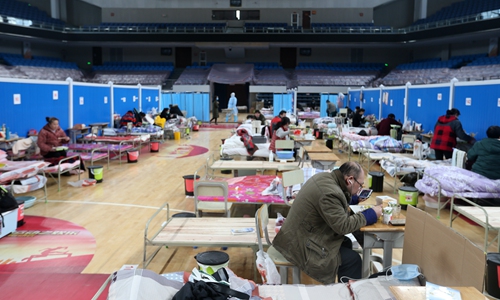HOME >> SOURCE
Hospital bed shortage poses great challenge for US medical system amid COVID-19 outbreak
Source:Global Times Published: 2020/3/18 18:19:43

A glimpse of patients' daily lives in Wuchang Fangcang makeshift hospital Photo: Cui Meng/GT
Available data on hospital capacity shows that countries seeing increasing confirmed COVID-19 cases like the US and Italy face greater risks treating patients as a result of hospital bed shortages.
According to the Organisation for Economic Co-operation and Development, the US has 2.8 hospital beds per 1,000 people. Other countries with serious COVID-19 outbreaks have more on average: Italy has 3.2 beds per 1,000 people, China has 4.3, South Korea has 12.3, and Japan has the most at 13.1 per 1,000 people.
Leaders in Northern Italy warned on Sunday that they were running out of beds, and US hospital staff say they are concerned about shortages of specialized equipment like hospital beds, according to recent media reports.
"The medical systems in countries lacking hospital beds could easily become overloaded during the virus outbreak," a medical worker based in North China's Tianjin Municipality surnamed Guo told the Global Times on Wednesday.
It seems that countries facing a lack of hospital beds and which have increasing number of confirmed cases have relatively weak capacities to handle the impact of the virus, as a bed shortage during a pandemic inevitably increases the mortality rate, Guo said.
A lack of hospital beds also posed great challenges for treatment in Wuhan, the city hit hardest by the virus in Central China's Hubei Province, in the early stages of the outbreak in January, when there were just 2,000 hospital beds in the city for infected individuals, media reports said.
But the city proved it is possible to moderate bed restrictions through the rapid construction of makeshift hospitals to meet rising demand.
In within two weeks from late January, Wuhan built the Leishenshan and Huoshenshan hospitals to provide over 2,000 beds for sick people. The city later built 16 further Fangcang makeshift hospitals.
By February 20, Wuhan had increased its number of suitable beds to more than 40,000. The city is now equipped with 7.4 hospital beds per 1,000 people, according to data compiled by domestic news site ifeng.com on Tuesday.
There are more than 67,000 confirmed coronavirus cases in Wuhan and over 56,000 people have recovered as of press time.
It is expected that countries like the US could increase their hospital capacity by converting public facilities such as stadiums and exhibition halls into temporary hospitals, but it will be hard for them to enhance capacity on a large scale within a short time as China has done, said Zhou Zijun, a professor at Peking University's School of Public Health.
"It is because we have different social systems," Zhou told the Global Times on Wednesday. Analysts said that countries like the US will fail to conduct unified allocations of resources.
The number of confirmed novel coronavirus cases surpassed 5,000 in the US on Tuesday, a fivefold increase in seven days, according to CNBC.
Despite China's efforts, the current capacity of Chinese medical institutions, including beds and health technicians, has still not been able to meet the demand faced in such an emergency, experts said, noting that the epidemic has revealed a domestic shortcoming in the public health sector: insufficient investment, which is expected to be improved.
In 2019, there were 6.97 million beds in hospitals across China, including 1.38 million beds in health clinics in rural areas, according to the National Bureau of Statistics.
Posted in: ECONOMY